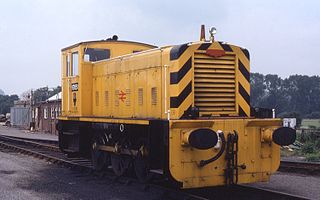| Number | Previous number(s) | Previous class | Converted | Use | Withdrawn | Disposal |
|---|
| DS49 | 49S | - | New (1940) | Diesel shunter, Exmouth Junction | 1959 | Scrapped |
| DS74 | 74S | - | New (1899) | Electric shunter, Durnsford Rd power station | 1965 | Scrapped (1965) |
| DS75 | 75S | - | New (1898) | Electric shunter, Waterloo & City line | 1968 | Preserved at National Railway Museum [1] |
| DS77 | E0745 / 77S | C14 | 1927 | Steam shunter, Redbridge sleeper works | 1959 | Scrapped (1959) |
| DS209 | - | - | New (1966) | Diesel shunter, by Secmafer of France | 1968 | Returned to Secmafer |
| - | A313 / 225S | ? | 1925 | Steam shunter, Meldon Quarry | 1939 | Scrapped (1939) |
| DS233 | 30061 | USA | 1962 | Steam shunter, Redbridge sleeper works | 1967 | Scrapped (1967) |
| - | A302 / 234S | - | 1925 | Steam crane tank, Lancing Works | 1938 | To capital stock - 1302 (Scrapped 1949) |
| DS234 | 30062 | USA | 1962 | Steam shunter, Meldon Quarry | 1967 | Scrapped (1968) |
| - | A409 / 235S | - | 1925 | Steam crane tank, Ashford Works | 1935 | Scrapped (1935) |
| DS235 | 30066 | USA | 1963 | Steam shunter, Lancing Works | 1965 | Scrapped (1965) |
| - | A353 / 236S | ? | 1925 | Steam shunter, Ashford Works | 1929 | Scrapped (1932) |
| DS236 | 30074 | USA | 1963 | Steam shunter, Lancing Works | 1965 | Scrapped (1965) |
| DS237 | 30065 | USA | 1963 | Steam shunter, Ashford Works, named Maunsell | 1967 | Preserved |
| DS238 | 30070 | USA | 1963 | Steam shunter, Ashford Works, named Wainwright | 1967 | Preserved |
| DS239 | 31592 | C | 1963 | Steam shunter, Ashford Works | 1966 | Preserved |
| DS240 | 31271 | C | 1963 | Steam shunter, Ashford Works | 1966 | Scrapped (1967) |
| DS343 | 343S | - | New (1930) | Diesel shunter, Eastleigh Works | 1952 | Scrapped |
| DS346 | 346S | - | New (1915) | Drewry Inspection Saloon | 1949 | Scrapped |
| DS377 | 2635 / 377S | A1X | 1946 | Steam shunter, Brighton Works | 1959 | Transferred to capital stock - 32635 |
| - | B682 / 380S | A1 | 1932 | Steam shunter, Brighton Works | 1946 | Preserved |
| DS400 | 400S | - | New (1946) | Diesel shunter, Southampton Docks | 1957 | Scrapped |
| DS499 | 499S | - | New (1935) | Diesel shunter, Lancing Works | 1965 | Scrapped |
| DS500 | 1607 / 500S | T | 1938 | Steam shunter, Meldon Quarry | 1949 | Scrapped (1950) |
| DS515 | B650 / 515S | A1X | 1937 | Steam shunter, Lancing Works | 1953 | Transferred to capital stock - 32650 |
| DS600 | 600S | - | New (1947) | Diesel shunter, Eastleigh depot | 1963 | Scrapped (1969) |
| DS680 | A751 / 680S | A1 | 1932 | Steam shunter, Lancing Works | 1962 | Preserved |
| DS681 | 32659 | A1X | 1953 | Steam shunter, Lancing Works | 1963 | Scrapped (1963) |
| DS682 | 30238 | G6 | 1960 | Steam shunter, Meldon Quarry | 1962 | Scrapped (1963) |
| DS700 | 2244 / 700S | D1 | 1947 | Oil pumping locomotive (steam), Eastleigh | 1949 | Scrapped (1949) |
| DS701 | 2284 / 701S | D1 | 1947 | Oil pumping locomotive (steam), Fratton | 1951 | Scrapped (1951) |
| DS1169 | - | - | New (1948) | Diesel shunter, named Little Eva | 1972 | Scrapped (1973) Preserved North Dorset Railway |
| DS1173 | - | 04 | New (1948) | Diesel shunter, Hither Green depot | 1967 | Transferred to capital stock - D2341 |
| DS3152 | 30272 | G6 | 1950 | Steam shunter, Meldon Quarry | 1960 | Scrapped (1960) |
| DS3191 | 30612 | A12 | 1946 | Steam supply, Eastleigh Works | 1951 | Scrapped (1951) |
|







